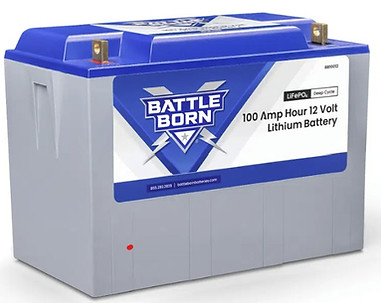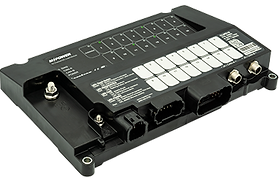

Lighting Package
Lighting and the way you use it is the reflection of function and purpose. That is why we only use top quality products and apply them with function and purpose. Our ample cabin and deck lights are RGBW LEDs to allow the user to customize lighting color and intensity. Our digital lighting control system allows for lighting presets. We have two underwater lights selectable blue or white for effect and to attract fish.
The well appointed spot and flood lights are mounted to avoid back reflection from the foredeck to the helm. We do offer optional remote pan and tilt for the spot light.
Navigation lights are fully compliant with CFR 33 CH1 E P83 for vessels under 12 meters.




BattleBorn Batteries
There are some components that just will not tolerate compromise, and we use the highest quality LiFEPO4 batteries on the market. Our standard fit uses two BattleBorn100Ah Expandable to four} independent batteries that are switched for house power and deep draw starting current. The battery system has combined shore power charging but isolate when shore power is dropped. Each BattleBorn internal BMS is networked through the battery HUB to the NMEA 2000 network. This reports state of charge {SOC} and condition of each battery including temperature, cell balance and includes heaters to compensate for very cold weather use.
Features:
-
Designed for Versatility with the ability to be wired in series or parallel and mounted in any orientation
-
Safe & Reliable lithium iron phosphate (LiFePO4) chemistry
-
Rugged Battery Design built for marine applications
-
Lightweight at just 31 pounds for 100Ah of usable power power
-
Long-lasting with 3,000-5,000 deep discharge cycles providing up to 10-15 years of power
-
Internal BMS featuring low-temperature protection, high and low voltage, short circuits.

Intelligent Charging
The shore power charger {option} is a six stage Victron 85-250 AC that will charge all batteries simultaneously. Designed for marine use the Bluetooth wireless solution to set-up, monitor, control, and update this Smart IP43 Chargers. Smart IP43 Charger (1+1): two outputs to charge 2 battery banks The second output, limited to approximately 4A and with a slightly lower output voltage, is intended to top up a starter battery.
The charger automatically compensates for voltage drop over the DC cabling by slightly increasing output voltage when the DC current increases.
An adaptive charge algorithm: bulk– absorption – recondition – float – storage – refresh, features “adaptive” battery management system {BMS} that can be preset to suit different types of batteries including LiFePO4. After a deep discharge the absorption time is automatically increased to make sure that the battery will be fully charged.
Preventing damage due to excessive gassing, a high charge current in combination with a high absorption voltage has been chosen, the charger will prevent damage due to excessive gassing by automatically limiting the rate of voltage increase once the gassing voltage has been reached.
The Storage Mode kicks in whenever the battery has not been subjected to discharge during 24 hours. In the Storage Mode float voltage is reduced to 2,2 V/cell (13,2 V for a 12 V battery) to minimize gassing and corrosion of the positive plates.
Once a week the voltage is raised back to the absorption level to ‘equalize’ the battery. This feature prevents stratification of the electrolyte and sulphation, a major cause of early battery failure. Also charges Li-ion (LiFePO₄) batteries Charger on-off control can be implemented by connecting a relay or open collector optocoupler output from a Li-ion BMS to the remote on-off port.
Power Distribution
The power distribution is managed by remote switched digital switching on one of four individually fused. The remote digital switching is fused.
Bus A is for engine start
Bus B - Lighting
Bus C Electronics and displays
Bus D Winch
Each circuit is separately switched and can use battery 1 or 2 or both.
The remote switching system is controlled through the NMEA 2000 digital communications. Remote switching can either be controlled from the console or from the screen of the MFD {Furuno, Simrad, Garmin}. All remote switches have electrical circuit breakers and are waterproof IP67 rated.
Remote Switching Features
-
NMEA 2000® Interface
-
IP67 Rated
-
Ignition Protected
-
Opto-isolated from NMEA 2000®, eliminating potential ground loops
-
Individual fused electrical current monitoring
-
All inputs and outputs protected against short to power and short to ground
Control Panel Features
-
NMEA 2000® CAN Protocol
-
IP68 Sealing Protection with plug installed in unused connector
-
Configurable
-
Horizontal or Vertical Mounting Options
-
Aftermarket Actuators readily available with a wide selection of Legends
-
LED feedback of circuit state
-
Low Current Switching
-
Tactile and Audible Feedback
-
Blown fuse indication on switch and chart plotter {if fitted}
CZone NMEA 2000 digital power control
-
NMEA 2000® CAN Protocol
-
IP68 Sealing Protection mounted in power control panel
-
Easy access inline fused with failsafe bypass
-
LED lighting control
-
Horn
-
Anchor winch {option}
-
Trim Tabs
-
MFD interface to all major chart plotters






Cables and Conductors
ABYC Standards
The American Boat and Yacht Council (ABYC) sets the gold standard for marine electrical systems in North America.
Their standards require marine cables to be stranded copper wire with type III insulation at minimum.
The ABYC also specifies proper wire sizing, voltage drop limits (3% maximum), and installation practices.
ISO and UL Standards
Internationally, the ISO 13297 standard governs small craft electrical systems. UL 1426 certification specifically addresses "Electrical Wires and Cables for Boats" and requires extensive testing for flame resistance, oil exposure, and water absorption. These standards ensure marine cables perform safely even under extreme conditions.
Tinned Copper Conductors
The most obvious difference in marine cables is the silver appearance of tinned copper conductors. This tin coating protects against corrosion in salty, humid environments. The tinning process creates a barrier that prevents oxidation and significantly extends the cable's lifespan.
The science behind tinned copper is fascinating and explains why it's the preferred choice for marine environments.
Insulation Requirements
Marine cable insulation must be:
-
Moisture resistant
-
Oil and fuel resistant
-
UV resistant
-
Flame retardant
-
Flexible across temperature ranges (-40°C to +105°C typical)
Common marine-grade insulation materials include cross-linked polyethylene (XLPE), polyvinyl chloride (PVC) with specialized additives, and premium thermoplastic elastomers.
AWG Sizing Requirements
Application AWG Max Current
Bilge pump 16-14 AWG 10-15A
Navigation lights 16 AWG 10A
Cabin lights16-14 AWG10-15 amps
Battery cables (<10ft) 4-2/0 AWG 100-300A
Battery cables (>10ft) 2-4/0 AWG 150-400A
Flame Retardancy
Marine cables must self-extinguish to prevent fire spread. The UL 1426 standard requires cables to pass a flame test where the cable must stop burning within a specified time after the flame source is removed.
Low Smoke Zero Halogen
Premium marine cables often feature LSZH (Low Smoke Zero Halogen) jacketing. These materials release less toxic smoke during a fire emergency, critical in the confined spaces of a vessel where evacuation options are limited.
Installation Requirements
Proper installation is just as important as using the right cables. Marine cable installation must follow these key requirements:
-
Support cables every 18 inches
-
Use strain relief at termination points
-
Keep cables away from bilge areas when possible
-
Use waterproof connectors with heat-shrink tubing
-
Never use wire nuts or residential-type splice connectors
-
Maintain minimum bend radius (typically 5x cable diameter)
-
Route cables away from exhaust components and moving parts



